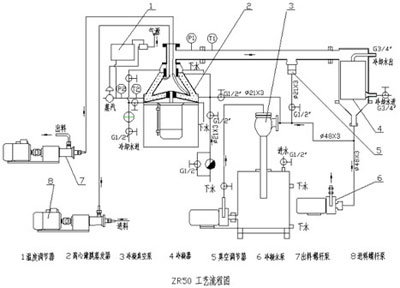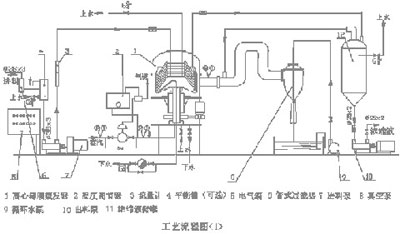1. Centrifugal Thin Film Evaporator Overview Centrifugal thin film evaporator is a new type of efficient heat transfer equipment. The utility model has the advantages of small equipment volume, high evaporation intensity, low evaporation temperature of the material, short heating time, large concentration ratio, high final concentration of the material and convenient removal and washing of the evaporation chamber. Therefore, it is widely used in the pharmaceutical, food, chemical and other industries, especially for the concentration of heat sensitive materials, viscous materials, or materials with foaming tendency. Unlike conventional evaporation equipment, a centrifugal thin film evaporator can be a new type of evaporator because it successfully combines the two working principles of thin film evaporation and centrifugal separation. In the centrifugal thin film evaporator, the feed liquid film is subjected to centrifugal force, and its value is more than one hundred times of gravity, thereby greatly improving the conveying capacity of the material on the heating surface, increasing the flow rate, and the heat transfer coefficient is as high as 4200- 4650 watts / square meter, and has the potential to achieve higher final concentrations, discharge solids up to 85% and suitable for higher viscosity materials. (Feed viscosity up to 20000cP) The material flow rate increases rapidly, that is, the residence time on the heating surface is short, (generally the diluted liquid solution is only 1 second), the effective component destruction of the material is reduced, and the original color, fragrance, and Flavor, suitable for heat sensitive materials. The centrifugal force causes the steam condensate to not adhere to the heating wall surface, so that the heating steam reaches the droplet condensation, and a very high heat transfer coefficient is obtained. When the steam condensed water is thrown from the steam inlet of the cone disk, the heating steam is not overheated. . The centrifugal force also makes the vapor-liquid phase of the material separate well, and the product yield is high, and the material has good adaptability to the foaming tendency. In addition, the centrifugal force also facilitates the discharge of the concentrated material and the coagulated water under vacuum. Another advantage is that the volume of the material in the evaporator is small. For example, the total volume of the ZR-800 material is only 1.5 liters at any given time, so if there is an accident and the machine is shut down, the amount of product lost in the evaporator is only It is 1.5 liters. 2. Technical Parameters: model ZR-50 ZR-400 ZR-800 ZR-1300 Evaporation capacity 50 kg / h 400 kg / h 800 kg / h 1300 kg / h Heat transfer coefficient 4000 watts / square meter. Open 4000 watts / square meter. Open 4000 watts / square meter. Open 4000 watts / square meter. Open Evaporation chamber vacuum 10-18 kPa 10-18 kPa 10-18 kPa 10-18 kPa Heating steam absolute pressure 0.07-0.15 MPa 0.07-0.15 MPa 0.07-0.15 MPa 0.07-0.15 MPa Conical disk diameter 280 mm 490 mm 650 mm 650 mm Number of conical discs 1 6 6 9 Number of revolutions 1430 rpm 800 rpm 600 rpm 600 rpm 3. Typical process flow of complete equipment: 3.1ZR-50 centrifugal thin film evaporator ZR?50 centrifugal thin film evaporator process flow chart As shown in the above figure, the feed liquid is sent from the feed screw pump 8 to the centrifugal thin film evaporator 2, and the flow rate is adjusted by the frequency converter controlling the screw pump speed, and the liquid is concentrated in the evaporator by vacuum or atmospheric pressure. Controlling the heating steam temperature (the value is given by the temperature regulator 1) and the feed amount to reach a predetermined process concentration requirement, and the concentrated feed liquid is passed through the discharge pipe through the discharge screw pump 7 by the centrifugal force to concentrate the liquid Send to the next process. The heating steam is controlled by the regulating valve (ZMANP-16K-15), and can be adjusted as needed within the absolute pressure of 0.02-0.2Mpa. The operation of the membrane regulating valve is adjusted by the WT-2 type temperature regulator 1, so as long as the temperature is adjusted The knob on the device 1 can change the given temperature value, and the heating steam temperature of the evaporator can be stabilized in the given value after the change. The condensate after the secondary steam is condensed by the spiral plate condenser (4) is taken out by the condensate pump (6). It can therefore also be used for the recovery of solvents. The outlet of the condenser (4) is connected to the condensate pump (6) in parallel with the vacuum pump (3) for removing the gas and maintaining the vacuum of the evaporation chamber. "The evaporation chamber vacuum can be between 0-680mmHg as needed. Adjustment, because the vacuum pump (3) is also connected in parallel with the vacuum regulator (5) on the secondary steam line, and has a "1/2" ball valve control. When the maximum vacuum is required, the "1/2" ball valve can be used. Close, when it is necessary to reduce the vacuum, open the "1/2" ball valve and turn the vacuum regulator (5) to adjust the vacuum to the desired value. The vacuum pump (3) is a water jet type, and the suction nozzle is also connected to the condensate water pipe of the steam chamber through a valve. When the steam temperature is lower than 100 ° C, the steam condensed water is extracted by the vacuum pump (3). The trap is equipped with a 1/2" bypass valve that opens the bypass valve slightly when the steam trap is not sensitive enough. 3.2ZR400, ZR800, ZR1300 centrifugal thin film evaporator Centrifugal thin film evaporator process flow chart The concentrated liquid is filtered through the pipeline filter (1) and then enters the balance tank (2). The balance tank is equipped with two float valves. The upper one feeds the liquid and maintains a stable liquid level; the lower float valve is a safety device. Once the liquid is interrupted, the water can be automatically entered to ensure that the main machine does not cause evaporation or coking due to material breakage. The flow rate of the feed liquid entering the evaporation host can be adjusted by the feed screw pump (3), and the flow rate is displayed by the flow meter, and then enters the host centrifugal thin film evaporator (5) for vacuum concentration. By controlling the temperature of the heated steam or the feed rate, the concentration of the concentrate can be varied to meet the desired process requirements. The concentrated feed liquid is sent to the concentrate storage tank (9) by centrifugal force, and then output through the discharge screw pump (10). The vacuum of the system is caused by the hydraulic jet pump (6). The upper water pressurized to 0.4-0.6 MPa is sprayed at high speed by the top of the jet pump to cause vacuum, taking away non-condensable gas, and simultaneously condensing the secondary steam in the extractor into the water tank (7). 4. How the host works: The evaporation working part of the centrifugal thin film evaporator is six conical discs. They are fixed to the drum and rotate with the hollow shaft, see process flow diagram (1). The conical disc is welded by two upper and lower stainless steel cones. The steam and steam condensate are taken in the middle of the two cones, and the ventral surface of the lower cone is the evaporation surface of the liquid. The upper cones of the conical disc are welded together, and a ring at the bottom of the conical disc is welded to the two cones. The ring has 20 axial holes and 40 radial holes. The axial holes are used for the circulation of the concentrated liquid, and the radial holes are used to introduce steam and discharge the condensation water. The material enters from the top of the evaporator and is sprayed through the distribution tube to the evaporation surface. The distribution pipe consists of a main pipe and six branch pipes. At the top of the branch pipe, there is a nozzle with a diameter of 3 mm, and the liquid is sprayed in the direction of rotation of the conical disk to prevent the droplet from splashing and affecting the yield. After the liquid is sprayed onto the evaporation surface, it is rapidly dispersed by the centrifugal force, and a liquid film having a thickness of about 0.1 mm is formed on the entire heating surface. The feed liquid takes only about one second from the inside to the outer edge of the cone due to the increasing centrifugal acceleration. The concentrate flows up through the axial bore of the edge of the conical disc to the hopper and is then output from the evaporator by a discharge tube in the tank. The heated steam is introduced into the drum from the center of the bottom of the evaporator, and then enters the disk through the radial hole at the edge of the cone. The steam condensate is sucked by the centrifugal force to the inner wall of the upper cone, and flows down the wall through the water vapor. The hole is returned to the condensate collecting tank and discharged through the condensate drain pipe located in the hollow shaft. The centrifugal thin film evaporator is also provided with a cleaning device. When the operation is finished, the water can be washed through the washing water main pipe and the nozzles of various angles to wash various parts of the evaporation chamber, and a satisfactory cleaning effect can be obtained. 
